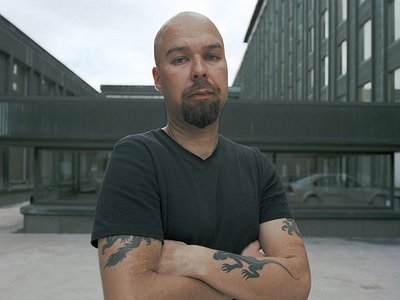Name: Mika Vainio
Nationality: Finnish
Occupation: Sound artist, producer
Current release: This interview was conducted around 2009/2010 and is presented here in a discretely edited form. Even after his passing, music by Mika Vainio continues to be released. Most recently, P V T with Charlemagne Palestine, and Eric Thielemans on Matière Mémoire, 2020. Other new albums include The Heat Equation on Touch, Live 2002 on Noton, and Lydspor One & Two on Moog Recordings Library.
If you enjoyed this interview with Mika Vainio and would like to find out more about his music, visit his official website.
Over the course of his career, Mika Vainio has collaborated with and appeared on releases with a wide range of artists, including Alva Noto, Charlemagne Palestine, Lucio Capece, Vladislav Delay, Barry Adamson, Merzbow, and Oren Ambarchi.
[Read our Alva Noto interview]
[Read our Charlemagne Palestine interview]
[Read our Lucio Capece interview]
[Read our Vladislav Delay interview]
[Read our Barry Adamson interview]
[Read our Merzbow interview]
[Read our Merzbow interview about improvisation]
[Read our Oren Ambarchi interview]
You've singled out the Einstürzende Neubauten and John Duncan as acts which were influential in a way for you. What made and still makes their work interesting to you?
The early Neubauten were impressive, as they could combine very agressive and brutal methods to sometimes arrive at the most delicate and refined musical thoughts. I have not been that interested in them after what they produced in the 80s, though.
As for John Duncan, other than for his impressive art works and performances, I respect the way he has been standing up against the controversy his work has often evoked and for staying faithful to his own ideas and ways of doing things - even if this has often meant a hard and austere life.
What, would you say, are ongoing fundamentals of your work?
For me, music is a method to understand and examine both the world and myself. To achieve this, I want to go to the micro-level of sound, to taste the tones of neutrinos. I think this is the key element in my musical approach.
Black Telephone of Matter, for example, took a lot of work. I spent a massive amount of time to find the right kind of sounds, to get the right combination of sounds and then finally to edit everything together in the right way.
For example, for the first track on the album, "Roma A.D. 2727," I had to create seven different versions before I was happy with it.
All in all, I worked on Black Telephone for a period of an entire year. And I was revising it continuously.
What did you start with for the tracks on this album?
For me, absolute music cannot exist. Sounds always evoke particular feelings inside me. The source of my own music is always to be found in emotions.
There are a lot of people doing music who are not musicians but merely technicians as they do not put anything of themselves into it.
Where does the impulse to create something come from for you? What role do often-quoted sources of inspiration like dreams, other forms of art, personal relationships, politics etc play?
My inspiration can come from many different kinds of sources: Visual arts, movies, the weather, books, science, news, nature, steaks in butcher shop etc ....
The approach for using particular sounds is actually quite consistent throughout the album, even though ideas and feelings came from many versatile sources.
How does that compare to your live- and installation-work?
Right now, I am in Brussels preparing my new sound installation in Lab[au]-mediaruimte gallery. This piece (still untitled ) will use 7 "tube" radios from the fifties.
[The piece would later be titled 2 x 540 kHz; Raster Media has a very nice overview of the project]
I am first recording sounds from radios, then producing a piece of music from this material. Then, all of this will be transmitted by a small radio transmitter and received and played back by same radios during the installation.
The installation will open November 13th.
German composer Jörg Widmann has mentioned that, to him, one of the hardest aspects is to stay true to your original idea while composing and to take the "necessary" decisions while working on a piece …
Sometimes, it is more interesting and easier to let the track go "its own way" and ending up with something quite different from what you originally intended.
On Telephone, I however managed to get the original idea across quite well.
There were already some discreet acoustic sounds on the previous Pan Sonic album Katodivaihe. What is the appeal of combining digital and acoustic material to you?
Combining acoustic and electronic sounds can make for a nice contrast. Like combining a photograph with a drawing in visual arts for example.
On this album, there are more acoustic sounds than one might possibly realise, as many of them are heavily processed.
To me, the importance of silence in your music has grown even more on this record …
Silence is the most important element for me. Just like in traditional Japanese architecture, empty space is the key element.
You carve space with materials.




